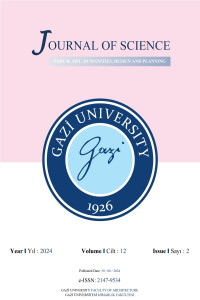Öz
Kaynakça
- [1] O’Reilly, T. (2007) What is Web 2.0: Design patterns and business models for the next generation of software. Communications & Strategies. 65(1), 17-37.
- [2] Hagen, P., Robertson, T. (2009) Dissolving boundaries: Social technologies and participation in design. Proceedings of the 21st Annual Conference of the Australian Computer-Human Interaction Special Interest Group: Design: Open 24/7, 129–136.
- [3] Darwish, A., Lakhtaria, K.I. (2011) The impact of the new Web 2.0 technologies in communication, development, and revolutions of societies. Journal of Advances in Information Technology. 2 (4), 204–216.
- [4] Özden, A.T. (2022) 1.0’dan 5.0’a Dünya: Web, Pazarlama, Endüstri ve Toplum. Journal of Business in The Digital Age. 5 (1), 29–44.
- [5] Castells, M. (2005) Ağ Toplumunun Yükselişi Enformasyon Çağı: Ekonomi, Toplum ve Kültür 1. Cilt. Bilgi Üniversitesi Yayınları, İstanbul.
- [6] Boyd, D.M., Ellison, N.B. (2007) Social Network Sites: Definition, History, and Scholarship. Journal of Computer-Mediated Communication. 13 (1), 210–230.
- [7] Kietzmann, J.H., Hermkens, K., McCarthy, I.P., Silvestre, B.S. (2011) Social media? Get serious! Understanding the functional building blocks of social media. Business Horizons. 54 (3), 241–251.
- [8] Tuten, T.L. (2020) Social media marketing. Sage Publications, London.
- [9] Kaplan, A.M., Haenlein, M. (2010) Users of the world, unite! The challenges and opportunities of Social Media. Business Horizons. 53 (1), 59–68.
- [10] URL-1. DIGITAL 2024: TURKEY. https://datareportal.com/reports/digital-2024-turkey Last Accessed: 26.05.2024
The Role of Social Media in Shaping Industrial Design Practices: Insights from Turkish Practitioners
Öz
With the inclusion of internet technology in daily life, individuals have tended to conduct their social interactions in virtual environments. Social networking platforms, which bring together millions of people, have allowed people to move a large part of their living spaces to the virtual environment. These platforms, called social media, are occupying a more prominent place in our life day by day. Social media attracts great attention from users across a wide age range due to its interactive nature that allows interaction and gives individuals the opportunity to express their personal opinions.
This aim of the study is to examine the use of visual-based social media by industrial designers in Turkey and to analyse their usage habits. Since the research aims to measure the impact of social media on the industrial design profession, social media platforms were limited and the evaluation was made through visual interaction-based social media platforms.
During the data collection phase of the research, information was collected through a questionnaire distributed over the Internet to 269 industrial designers. The findings show that social media usage is inversely proportional to age; in other words, as age progresses, the duration of social media usage tends to shorten. It was determined that the device that users most frequently use to access social media platforms is the smartphone. In addition, statistical data on social media usage purposes were obtained.
Anahtar Kelimeler
Etik Beyan
Permission was obtained with the report of Gazi University Rectorate Ethics Commission Number: E-77082166-302.08.01-654178 Date: 09.05.2023.
Kaynakça
- [1] O’Reilly, T. (2007) What is Web 2.0: Design patterns and business models for the next generation of software. Communications & Strategies. 65(1), 17-37.
- [2] Hagen, P., Robertson, T. (2009) Dissolving boundaries: Social technologies and participation in design. Proceedings of the 21st Annual Conference of the Australian Computer-Human Interaction Special Interest Group: Design: Open 24/7, 129–136.
- [3] Darwish, A., Lakhtaria, K.I. (2011) The impact of the new Web 2.0 technologies in communication, development, and revolutions of societies. Journal of Advances in Information Technology. 2 (4), 204–216.
- [4] Özden, A.T. (2022) 1.0’dan 5.0’a Dünya: Web, Pazarlama, Endüstri ve Toplum. Journal of Business in The Digital Age. 5 (1), 29–44.
- [5] Castells, M. (2005) Ağ Toplumunun Yükselişi Enformasyon Çağı: Ekonomi, Toplum ve Kültür 1. Cilt. Bilgi Üniversitesi Yayınları, İstanbul.
- [6] Boyd, D.M., Ellison, N.B. (2007) Social Network Sites: Definition, History, and Scholarship. Journal of Computer-Mediated Communication. 13 (1), 210–230.
- [7] Kietzmann, J.H., Hermkens, K., McCarthy, I.P., Silvestre, B.S. (2011) Social media? Get serious! Understanding the functional building blocks of social media. Business Horizons. 54 (3), 241–251.
- [8] Tuten, T.L. (2020) Social media marketing. Sage Publications, London.
- [9] Kaplan, A.M., Haenlein, M. (2010) Users of the world, unite! The challenges and opportunities of Social Media. Business Horizons. 53 (1), 59–68.
- [10] URL-1. DIGITAL 2024: TURKEY. https://datareportal.com/reports/digital-2024-turkey Last Accessed: 26.05.2024
Ayrıntılar
| Birincil Dil | İngilizce |
|---|---|
| Konular | Endüstriyel Ürün Tasarımı |
| Bölüm | Endüstriyel Tasarım |
| Yazarlar | |
| Yayımlanma Tarihi | 30 Haziran 2024 |
| Gönderilme Tarihi | 31 Mayıs 2024 |
| Kabul Tarihi | 30 Haziran 2024 |
| Yayımlandığı Sayı | Yıl 2024 Cilt: 12 Sayı: 2 |

